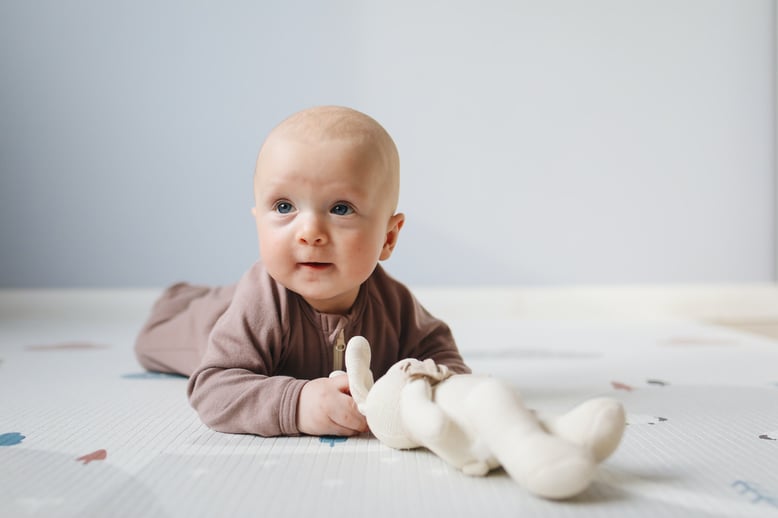The first time your little pumpkin rolls over is undoubtedly an exhilarating experience, especially for first-time parents because it's the first sign that your little one is starting to be mobile. Your baby is starting to get stronger and is discovering new and exciting ways to move his body!
Since rolling over is an important milestone in your baby's development, you might have questions about when babies roll over or how can you prepare your little one for this exciting moment. What should you do if your baby doesn't roll over? Let's answer all these questions.
The Age When Babies Roll Over
Babies develop at different paces, so there is a range when it comes to when babies start to roll over. However, on average, most babies begin to show signs of wanting to roll when they're about three months old.
Starting about three months, your baby will have enough upper body strength and muscle to use his arms to roll from his back to the side. Around four to five months, he'll have the ability to roll from his tummy to back.
With practice, by the time your little one reaches six months old, he will have mastered rolling over. You'll see him doing the stomach-to-back roll and the reverse back-to-stomach maneuver.
Signs Your Baby Is Getting Ready To Roll Over
Babies roll over when their body is ready, and you should never try to force your little one to roll over no matter how much you want it to happen. However, there are some physical signs you can look out for to tell you he's almost ready to do that much-anticipated maneuver.
- He lifts his head and shoulders using his arms for support.
- He is pushing up on his hands when he's on his stomach.
- He raises a hand in the air while pushing off his belly.
- He moves a leg across his body while lying on his back.
When you see these signs, it won't be long before he will do his first roll.
Preparing Your Baby To Roll Over

Rolling over requires a lot of back, neck, and arm strength from your baby. You can help him build the strength he needs by frequent tummy time or laying him down on his stomach. It's recommended to start introducing him to tummy time as early as a few weeks after he's born. You can do this by laying him across your lap when he is awake.
As your baby progresses, you can increase his tummy time under your watchful eye for as long as 20 minutes each time.
Encourage your little one to roll over by making it fun. Try putting your baby's favorite toy (or his favorite person - you!) nearby so he can reach for it, and in the process, build arm strength and muscle. Some babies even do a side roll while reaching for the objects of their affection. Applaud his efforts with lots of smiles, claps, and words of encouragement.
Keeping Baby Safe
Practicing rollover is an exciting time for you and your baby, but make sure that he's safe during this time. Always practice tummy time on a flat surface in your house and avoid floor time in rooms with stairs. If that's not possible, make sure the stairs are blocked off with a safety gate.
Move all potentially dangerous objects out of his reach because babies are inherently curious and can try to reach objects near them. If you can, don't leave your little one alone with your fur babies (dogs or cats) because your little pumpkin can roll over to your animal and startle them, making them react impulsively. Even if your pets are well adjusted to baby, it's still a good idea to keep them apart during this unpredictable time.

What To Do if Your Baby Doesn't Roll Over
Babies on average roll over between 4-6 months. However, this is just an average, and your baby might roll sooner or later than this average. Remember, babies develop skills differently, so there is no need to be alarmed if your baby is not rolling over on a "schedule". Some babies even sit up first before rolling over or skip rolling together and go on to crawl. Premature babies also have tendencies to roll over later than their peers.
However, there are some red flags that you might want to be aware of:
- Your baby has stiff arms and legs.
- He can't sit on their own by nine months.
- Your baby is not responsive to his name or noises.
- He doesn't like you to hold him.
- Your baby seems to have difficulty controlling his movement.
You can also check the guide to 4 month baby milestones, , which includes details on 4-month-old baby's physical and cognitive development, food habits, sleep, and other care basics.
If you have any concerns about your little one's development, discuss these with your pediatrician on your next visit.
Don't miss a moment with Pixsee!
Sometimes important milestones like rolling over happen when you're not looking. You'll never have to worry about missing a moment with Pixsee. Our smart baby monitor can automatically take images and video when it detects movement from the baby. If they happen to do their first roll during naptime while you're away, you'll still be able to capture it!
Our smart baby monitor is designed to help you capture every precious moment with your little one, even the candid ones you weren't expecting! In addition to auto-capture with smart detection, Pixsee also offers covered face detection, crib "safe area" monitoring, and Night Hawk advanced night vision to help ensure the baby is safe.
We want to help parents like yourself have peace of mind as you navigate the sometimes-overwhelming journey of parenting a newborn. To learn more about Pixsee's award-winning features, visit our Pixsee Shop and Amazon online store.







